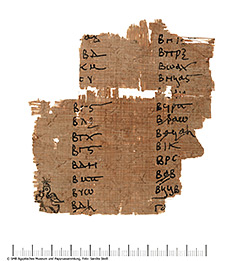SB XXII 15312 (P. 11702)
An odd drawing, a multiplication-table and a bird! All of this can be found on a Berlin papyrus and gives puzzles. What does that mean? In what context are these elements related to each other? What does a bird have to do with mathematics? Who wrote them?
The papyrus was acquired in the Middle Egyptian Ashmunein, the ancient Hermupolis, and came to the Berlin papyrus collection in 1908. It is likely, that the papyrus is from Hermupolis as well. Both sides have writing. However, no edges on the paper are preserved, so that the original extent of the text is no longer determinable. Because of the content of the text one can assume, that only a little part of the original papyrus has survived. Two columns in Greek have survived on both sides of the papyrus, along with drawings whose connection to the text remains unclear. The text can be dated to the 5th century due to the writing. At the end of the text, the writing becomes more and more hurried and careless. The spacing also decreases increasingly and appears more unstructured.
The text is a multiplication exercise, which shows us, from the writer’s perspective, the functioning of the decimal system. For this purpose, the writer of this exercise used the so-called Milesian numerals. For the digits, not own symbols are used, as it is done nowadays, but the letters of the alphabet and a few special characters. The tens and hundreds had their own letters and characters. Thus, α stood for 1, β for 2 and ξ for 60. Numbers, which were higher than nine, but were not tens or hundreds, were attached to the closest, smaller tens, hundreds, etc. and appended with the corresponding desired units. Therefore 63 was written with ξ for 60 and γ for 3.
The multiplication exercise is divided into several series and sections, some of which are marked by horizontal lines, so-called paragraphoi, at the beginning of the line. The remnants of the series with the factor 2, 3, 4 and 5 have survived. It can be assumed that the original list ranged up to a factor of ten. The series were divided into several sections, in which the first factor is multiplied with the numbers ranging from one to ten and the tenfold, hundredfold and thousandfold of this number. An entry has the following scheme: δ ϡ Γχ (in our digits: 4 900 3600, so 4 x 900 = 3600). The above already mentioned hastiness of the writer is thereby confirmed, that the second to last entry (ε ϡ Δφ[in our digits: 5 900 4500, so 5 x 900 = 4500]) was recognizably corrected.
On the right to the next column on the verso (back side) a 6 cm high and 2.4 cm wide drawing can be identified, which is neither part of a decorative strip, nor can it mathematically be explained. The drawing consists of two parallel, vertical lines, which are flanked on either side by irregularly jagged lines. The space between the prongs is filled with dots as well as semicircular ones. The drawing could be a cartographic depiction of the Egyptian eastern desert. The parallel lines would then be a wadi resp. a path, which demonstrate the jags flanking hills or mountains. The drawing must have been made after the multiplication list, as it partially overwrites it and the ink has a different iron content.
On the recto (front page) a frontal depicted bird, with raised wings, can be seen by looking at the bottom left of the multiplication exercise. Over the bird a small line can be found – an indicator for another, previous column or drawing. The drawing was carelessly drawn and due to the rough styling the zoological classification is very difficult. Possibly it’s the drawing of an eagle or a pigeon. Against an interpretation as a pigeon speaks that is represented in antiquity rather rarely frontal and with outstretched wings. On the contrary, eagles are often represented like this and symbolize something holy, like e.g. the revival of Jesus Christ. If the drawer was aware of this motive tradition can only be assumed, but normally he should have been aware of the meaning. The star above the head of the bird could, regarding this theory, be a christogram. The drawing of the bird and multiplication list were probably made in a timely manner, since there are no visible differences between the ink.
The correlation between the drawing and the multiplication list remain unclear. Mathematic and cartographic skills were needed in administration and the military in antiquity. Thus, this papyrus could be a reminder note or even a smear sheet from an apprentice in one of these areas. At last, the speculations remain uncertain and the papyrus a puzzle.



